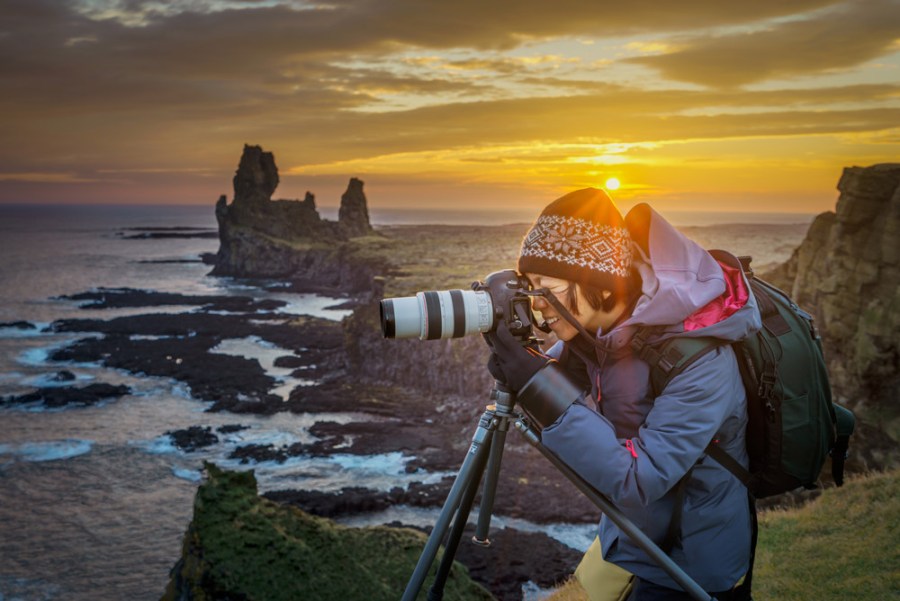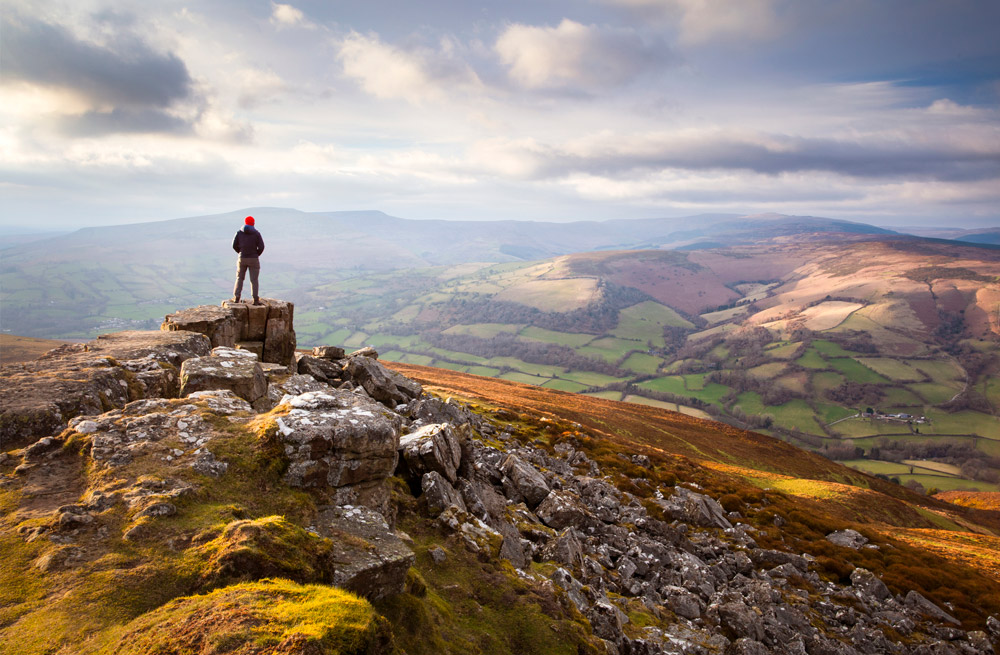This is your complete guide to landscape photography – from defining it, the kit you need, initial camera settings, to what goes into taking and making great landscape photographs; including light, composition, editing, competitions and more!
What is landscape photography?
Landscape photography is the art of capturing natural scenery or landscape. Typically it depicts a wider, open space rather than small details. It can include people, animals or man-made structures, but is always about the great outdoors. It can be your way of showing how you see the world around you and capture the beauty of an environment.
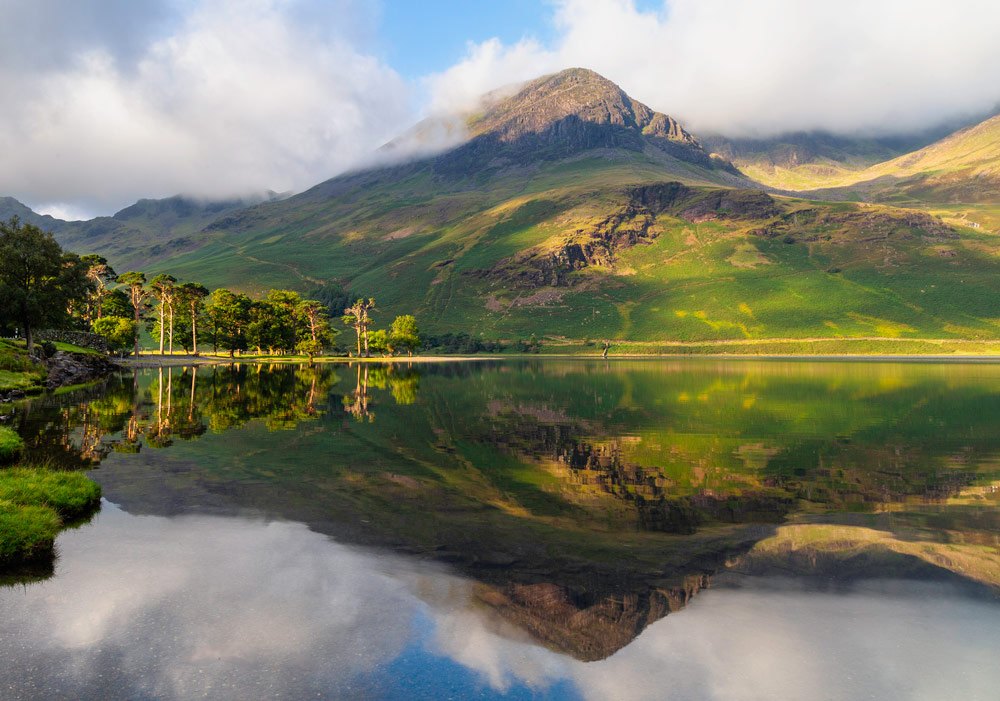
What kit do I need for landscape photography?
- A camera plus a lens that has a wide-angle view of 28mm or wider is a great place to start. Some will want an even broader view, so a 24mm or wider lens would be a good choice, particularly for capturing vast scenes and big open spaces. Find the best camera for landscapes, plus the best wide-angle lenses. A smartphone is also a great option for landscapes, as they normally come with wide-angle and ultra-wide-angle cameras.
- A tripod will help, especially to capture scenes with water, which are smoothed by longer exposures; or when you want to use a lower ISO speed for maximum image quality. Shutter speed is a lesser concern when your camera is stable and steady on a tripod.
- Filters – use a polariser if you want deeper blues and fewer reflections from leaves and water. Graduated filters are great for darkening the bright skies but leaving the rest of your image unaltered. If you want even longer exposures, then an ND filter will be needed.
- Clothing – weather appropriate apparel is just as essential as your camera, as you may spend hours walking around to find the best viewpoint or waiting for the light to hit your scene just the right way.

Camera settings for landscape photography
Landscape photography is all about light, location and composition. Where you place objects or how you frame the scene before you are key components; but also the camera settings you use play an important part in getting a sharp, detailed shot.
Remember the elements that make up your exposure: aperture, shutter speed, and ISO speed, as there are some recommendations here that will help when shooting landscape photography. For a refresher, have a look at our guide to exposure.
Here are the 4 main camera settings to pay attention to in landscape photography:
- Aperture
- ISO speed
- Shutter speed
- Focus
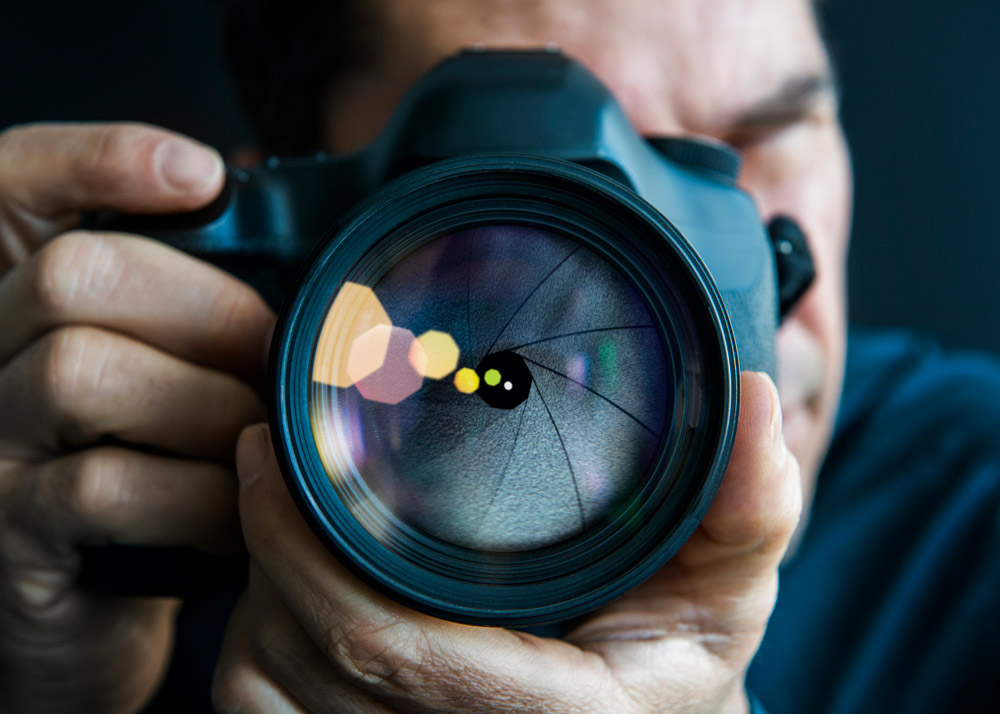
Aperture and depth-of-field
Depth-of-field – use a smaller aperture to ensure a lot of the scene is in focus, with as much of it as possible sharp and in detail. Closing the lens aperture down to f/8 – f/16 will get more of the scene in focus from the front of the image (things close to you) to the back of the image (things furthest away). This is also known as pan-focus, where everything in the image is in focus.
But beware of diffraction – if you stop the aperture down too far, such as f/18-f/22 or more, you will get softer images due to diffraction. The size of your camera sensor determines the point at which this becomes an issue – our macro photography guide contains our definition of diffraction. Note: Diffraction tends to kick in at f/11 on Micro Four Thirds, f/16 on APS-C, and f/22 on Full-frame cameras.
ISO speed
As we’ve said previously, the lowest ISO speed available will give the best results (with the most detail, and lowest noise). However, be aware that the camera you use may have a different low ISO speed to another camera.
On most, the lowest ISO speed is ISO100, but on some the lowest is ISO200. If you are tempted to use a “LOW” or (L) ISO speed on your camera, be aware that this is often an “extended” ISO speed, and results in reduced dynamic range.
So check what your actual low ISO speed is on your camera. If you’re not sure where to find this information, have a look at our review of your camera as it will state what the standard ISO range is, and the extended ISO range. Normally you want to avoid using the extended ISO range.
On many Olympus and Panasonic cameras, the low ISO speed is ISO200, and ISO100 is extended, which is shown as “Low” or L.100. Users of Fujifilm cameras need to check as some of these have the lowest (native, non-extended) ISO speed as ISO160.

Shutter speed
The best tripods for landscape photography allow the use of slower shutter speeds to create beautiful effects at waterfalls like the one seen above. Even the smallest movement, like pressing the shutter release button, can blur images. The self-timer or a remote to avoid camera shake at longer exposures can avert this. Alternatively, connect your camera to your smartphone and use it as a remote control. Another thing to be aware of is the camera strap – big ones can cause the camera to move if it’s windy. Make sure to weigh down your tripod with sandbags (or a heavy rucksack) to avoid movement.
If you use slower shutter speeds, you can blur the water, but any movement (in trees or scenery) will become blurred, too. To get really slow shutter speeds on brighter days, then you’ll need to use an ND filter.

Focus and front-to-back focus
To keep things simple, by using one focus point, you can control and know where you are focusing in your image. In landscape photography the challenge is to render as much as possible from the front of the image to the back of the image in focus.
Newer cameras often include “focus peaking” a useful tool that shows which elements of your scene are in focus by highlighting the edges with a bright colour. Don’t worry if you don’t achieve perfection, but try to focus on the main area of interest in the frame.
What makes for good landscape photography?
Light and location play a massive part in landscape photography, but are not the only aspects to think about when shooting landscapes. Breaking down what you include in your image can take your landscape photography from average to spectacular.
Here are 6 main things to consider when composing your shot:
- Light (and weather)
- Location
- Points-of-interest
- Leading lines
- Level (Horizon)
- Composition

Light, weather
Shooting in the “golden hour” (the hour before sunset or dusk, and the first hour after sunrise, dawn) will give a warm golden looking landscape. On the other hand “blue hour” after the sun has set and before it has risen will give images with a blue tone. Just before sunrise and after sunset are also great times to shoot, as the sky changes colours rapidly. For more examples have a look at our guide to outdoor light with David Noton.
Weather can dramatically change the light in the scene, as well as the look of a landscape image, so don’t be afraid to shoot when there is mist, fog, or even during or after a rain shower. A break in the clouds can turn a dull image into a striking image as can be seen in the example above. If your camera and lens are not weather-sealed, make sure you have a waterproof backpack or plastic bag to offer some protection for your kit in the worst of the weather.
…and Location
Shoot somewhere dull, and even with optimum lighting, an ideal camera, and perfect settings, you’ll still most likely end up with a dull photo. Landscape photography tends to include travel, and finding the most pleasant-looking locations and landscapes is part of the exciting appeal of the genre, be it near or far from where you live.
Check out some recommendations for the best landscape photography locations in the UK here.
Points-of-interest
To include people or not? By including people you can give a sense of scale, as well as potentially date the photograph to a certain period – depending on how visible the subject’s clothing/style/fashion is. The same goes for any other man-made objects included, such as buildings or vehicles. By including a subject or a person in the shot you add an additional element and give a sense of balance to the image.

Leading lines
If you think of the elements in an image as guiding the viewer through the frame, you can look for leading lines in the scene, such as a road heading towards an impressive mountain range, a river to a waterfall, or even the formation of rocks and land leading you through the image.
On the level?
Watch for the horizon and keep the camera level – use the camera’s built-in axis or dual-axis level if it has this, or look for the spirit level built into your tripod. If you don’t have these features, then you could pick up a simple spirit-level hot-shoe attachment for not much money.
Alternatively, activate the on-screen grid display if your camera has this feature. If you don’t manage to get it perfect in-camera, then you can always edit the image later to straighten up the image. Some modern cameras have a built-in horizon correction feature, so check the manual to see if yours has this.
Composition
All of these factors play a part in how you compose and frame your image, and how you place the elements in front of you into the photograph. If you’re just starting out in landscape photography, then using the “Rule of thirds” is a great place to start, but don’t be afraid to experiment with different framing. See our guide to the art of photography and composition for more ideas.
Other things to think about: You don’t always have to shoot vast landscapes. Instead you could zoom in to look at the finer detail, and this is where a macro or telephoto zoom lens could come in useful. If there is water in the scene, then look for reflections.
Aerial landscape photography: If you have access to a drone, then shooting from a high-angle can give a totally different look to your images. See our guide to aerial landscape photography for more information.
Intimate landscapes: Landscape photography doesn’t have to just be wide-angle, sweeping vistas. Try honing in on a smaller part of a scene for a more interesting alternative. See this guide to Intimate landscape photography.
Square landscapes: Landscape photos also do not have to be taken in landscape orientation. Changing to portrait or even square format can make an interesting composition. Transform your landscapes with square format here.
Editing Landscape images
It’s likely that you’ll need to (or want to) edit your photos to ensure you’re showing the landscape how you want to show it. Slight tweaks to contrast, saturation, and exposure to improve dynamic range in the image can make your images look better. You can also correct the image if it’s not entirely level.
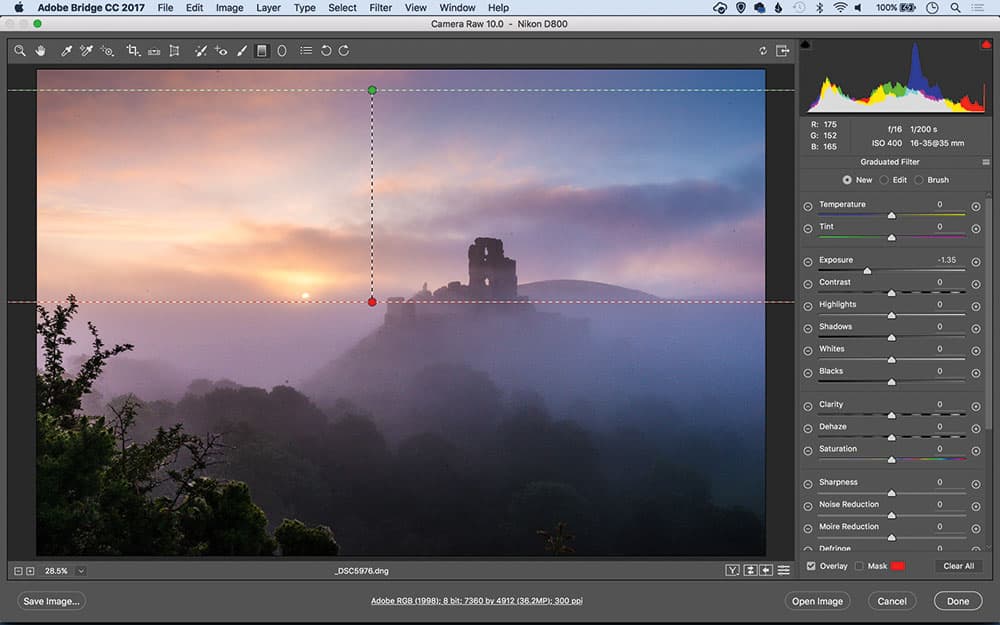
Expanding dynamic range – shooting using raw enables you to correct any errors in exposure or white balance. There is also the ability to expand the dynamic range in the image, which means you can recover shadows and dark areas, as well as recover highlights in the brighter areas.
Another option is to use exposure bracketing to help with this, but make sure you use a tripod so your images line up. Have a look at our guide to maximising dynamic range. Shooting raw also gives you the ability to tweak the sharpness and noise levels to get the very best out of the photo.
Landscape Photography Competitions
You can enter competitions to win prizes and recognition, as well as learn from others. Look out for landscape photography competitions such as the famous Landscape Photographer of the Year, and the International Landscape Photographer of the Year. There is also the landscape photography round of the Amateur Photographer of the Year Competition (APOY). Other general photography competitions feature Landscape categories, so have a look at our complete guide to the best photography competitions to enter.
More Landscape Photography Inspiration…
You’ll find a range of landscape photography articles here, and you can learn from professional photographers. We have articles from famous landscape photographers including Ansel Adams, William Garnett, Michael Kenna, Colin Prior, with AP contributors including Jeremy Walker, David Clapp, Verity Milligan, Rachael Talibart and Lizzie Shepherd to name a few. If you want to learn from the greats, make sure you have a look at their work.
For even more inspiration have a look at some of the landscape photography books available. AP’s own book, “Landscapes” is a great resource for learning even more.

Frequently asked questions
What is RAW?
What is a raw image? Cameras will by default save images as JPEG files, which are processed by the camera to produce the best-looking image, but this results in less control to edit and adjust the image. Shooting in the raw file format, you are getting the “raw” (uncooked, unprocessed) image from the camera, and therefore can edit it to your own personal tastes, as well as recover shadow or highlight detail that might have otherwise been lost if you’d only taken a JPEG image.
What is exposure bracketing?
Exposure bracketing is when you take several different images, but at different exposures. Most mirrorless and DSLR cameras have this feature, and it lets you take the same shot at different exposures, so for example, you could take one at -1EV, one at the normal exposure, and one at +1EV, allowing you to capture the darker and brighter parts of the image with more detail. You can then combine these images later in a photo editing package for an extended dynamic range. However, to get the best results your camera needs to stay in the same position for every shot, which is why a tripod is extremely useful for this.
Do I need a high-resolution camera for landscape photography?
The higher the better? Not necessarily, as some cameras with lower pixel-count have better low light capabilities than their high spec counterparts. Whether you need a higher pixel-count depends on how and what you shoot and how you intend to use your photos. For example, with a 16 MP camera you can achieve good print quality up to A2 size but if your photos never leave your computer this is really of no concern. You need more pixels or higher resolution if planning to print your photographs in large, or if you like to crop extensively. With more pixels, more detail is available in your image and you don’t loose quality and get pixelated images when cropping.
Instead of getting hung up on megapixels, what you really want to consider is the dynamic range of your camera.
What is dynamic range?
Essentially, dynamic range is how much detail your camera can record between the brightest and darkest part of your scene. The greater the dynamic range in an image, the more the camera has been able to capture the tones from dark black to bright white. In landscape photography, this becomes particularly important as there is often a big difference in light between the brightest area (often the sun), and the darkest areas of an image.
Sensor size affects dynamic range: in principle cameras with larger sensors are better at capturing a wider dynamic range. A 16MP crop sensor camera will generally have less dynamic range compared to a 16 MP full-frame camera, because the larger sensor will host larger pixels that are able to receive or read more light.
- Beginners guide to different camera types.
- Beginners guide to different lens types.
- Beginners guide to using a camera taking photos.
- Beginners guide to Exposure, aperture, shutter, ISO, and metering.
- How to get perfect colours – white balance explained
- 10 essential cameras accessories for beginners
- Beginners guide to the Art of photography and composition
- Beginners guide to Photoshop Elements and editing photos
- Complete guide to Portrait Photography
- Complete guide to Macro Photography
- Complete guide to Street Photography

